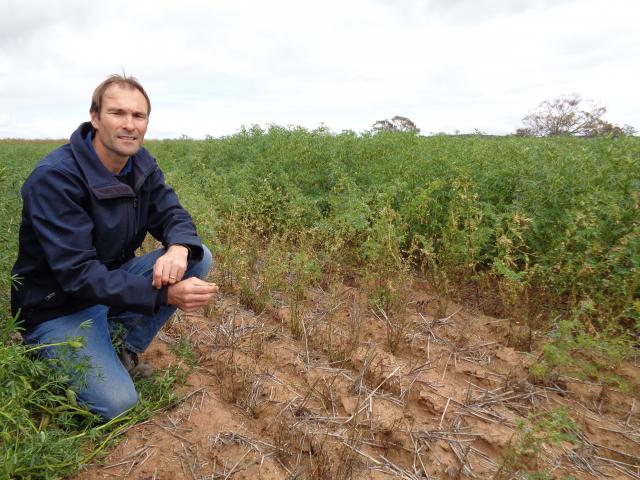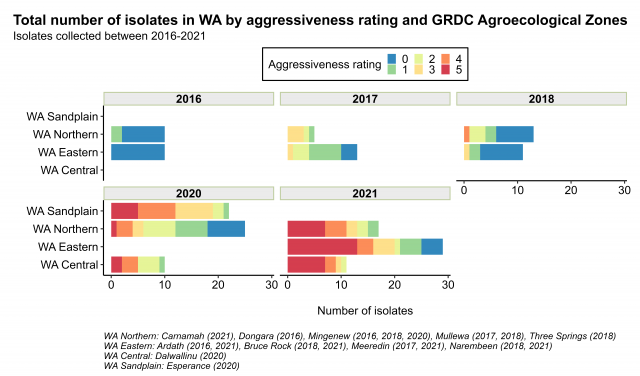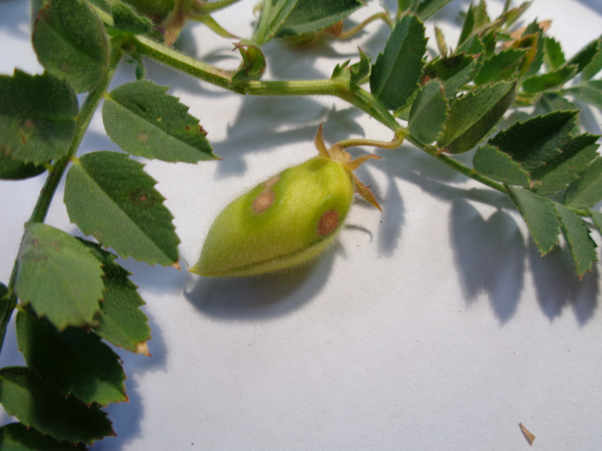Modelling to increase understanding of Ascochyta blight aggressiveness in chickpea crops

At a glance:
- Ascochyta blight is a significant disease threat to chickpea crops in Australia, in severe cases, this disease can cause complete yield loss.
- Plant breeding efforts since the early 2000’s have delivered chickpea varieties with resistance (R) or moderatley resistant (MR) to Ascochyta blight.
- The fungus that causes Ascochyta blight, Ascochyta rabiei (A. rabiei) can evolve and adapt rapidly to overcome disease resistance in these varieties. This has resulted in a loss of resistance in the commonly grown varieties over the past 5-10 years.
- Ascochyta rabiei strains are becoming more aggressive, exhibiting greater ability to overcome resistance and cause disease epidemics.
- Since 2013, more than 3,000 A. rabiei sample strains have been collected from chickpea crops across Australia, including WA, and stored in a database with information on where and when the sample was collected.
- Using the A. rabiei database, an Ascochyta blight disease model was developed by the Department of Primary Industries and Regional Development (DPIRD) l to help determine what factors lead to the ability of A. rabiei to overcome the resistance in commonly grown chickpea varieties.
- The model identified the major factors associated with A. rabiei aggressiveness primarily revolved around precipitation events in and out of the cropping season, chickpea host variety and the cropping region where the strain was collected. Insufficient data was available to verify the contribution of management practices to the increase in aggressiveness in strains.
Ascochyta blight, caused by the fungal pathogen Ascochyta rabiei (A. rabiei), is a constant threat to chickpea crops in Australia and disease epidemics can occur yearly. The disease appears as small patches of blighted or browning plants and spreads to healthy plants by rain splashes of spores. Under cool and or humid conditions, the pathogen can spread rapidly, infecting chickpea pods and seeds, reducing yields. In severe cases, Ascochyta blight has the potential to cause complete yield loss.
The pathogen survives between growing seasons on infected seeds, often saved and untreated, and in crop stubble in the paddock. In WA, severe epidemics have not been experienced for several years. However, in other parts of Australia, such as northern NSW, severe epidemics have occurred due to the high frequency of chickpea in crop rotations. The management of this disease is made more difficult because the fungus can evolve and adapt rapidly, overcoming varietal resistance.
As part of a Grains Research and Development Corporation (GRDC) funded initiative, a comprehensive national database was established to host information about A. rabiei collected from chickpea crops across Australia. Some strains of the fungus were selected from the national database to test their ability to cause Ascochyta blight infections, and the severity of the disease they caused on chickpea varieties with varying levels of resistance. The A. rabiei strains found in Western Australia (WA) that were selected and tested in this study were found to range from mild to highly aggressive. The more aggressive strains (pathotypes) have a greater ability to overcome varietal resistance to Ascochyta blight, leading to more disease epidemics in chickpea crops.

Research scientist Dr Rodrigo Pires (DPIRD) is involved in the GRDC national initiative in a collaborative project, being led by Griffith University collaborators Professor Ford and Dr Bar. The group is investigating the effect that cultural practices, climate and landscape have on the aggressiveness of A. rabiei. The project's primary focus is to identify the conditions that produce more aggressive strains. This information will be used in assessing future disease risk and to aid in disease management.
An Ascochyta blight disease model was developed using the results from aggressiveness testing (described above), chickpea production records, climate and soil data, the GRDC agroecological zone classifications, the chickpea variety being grown, and the GPS coordinates where samples were collected from. The model allows for factors such as rainfall, chickpea variety and GRDC agroecological zones to easily be changed and explore several different combinations that would otherwise take several years in which to gather data from paddocks. The model produces an estimate of the strain’s aggressiveness given these input factors. This method helps identify the factors that have the most effect on A. rabiei aggressiveness eliminating the need for years of field testing at multiple sites.
It was found that a combination of a high number of rainfall events, high annual rainfall amounts, and certain number of days where temperature was conducive for disease development and spread correlated to increased aggressiveness ratings. Moreover, higher aggressiveness also correlated with total rainfall outside of the cropping season suggesting the need to take action for disease management out of the cropping season (e.g., stubble management) as well as during the cropping season (e.g., fungicide applications).
Overall, the model suggested that precipitation related variables (i.e., yearly number of rainfall events, annual rainfall, in-season (May-Oct) rainfall events and out-of-season (Nov-Apr) rainfall), together with periods where temperature was favourable for disease development (between 20-30ºC), and chickpea cropping area (hectares under chickpea production) in each of the GRDC agroecological zones, explained most of the variation in aggressiveness ratings observed.
The model is being used to inform the selection of strains to help screen breeding material, better understand Ascochyta blight pathology and epidemiology research, and identify hotspots to locate variety trial sites.
The gradual increase in aggressiveness of A. rabiei strains in WA will mean that current, commercially available chickpea varieties are likely to become more susceptible to Ascochyta blight. Any grower that is finding more Ascochyta blight in their crop than is expected should not be surprised. For all varieties, irrespective of the varietal resistance status, a seed dressing should be applied prior to sowing. Growers also need to be prepared to apply foliar fungicide treatments to their crop if they are finding higher than expected levels of Ascochyta blight during the season.
For more information on Ascochyta blight refer to GRDC’s Groundcover article Firm foundations enable acid soil tolerant chickpea development or the Kondinin Group’s Farming Ahead article New chickpea variety may be an option for WA.

